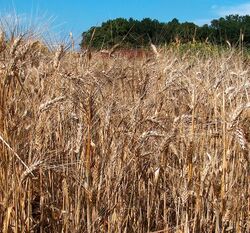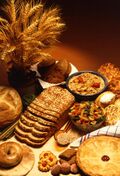Biology:Durum
| Durum | |
|---|---|

| |
| Durum wheat | |
| Scientific classification | |
| Kingdom: | Plantae |
| Clade: | Tracheophytes |
| Clade: | Angiosperms |
| Clade: | Monocots |
| Clade: | Commelinids |
| Order: | Poales |
| Family: | Poaceae |
| Subfamily: | Pooideae |
| Genus: | Triticum |
| Species: | T. durum
|
| Binomial name | |
| Triticum durum | |
| Synonyms[1] | |
|
List
| |
Durum wheat[2] (/ˈdjʊərəm/), also called pasta wheat[3] or macaroni wheat (Triticum durum or Triticum turgidum subsp. durum),[4] is a tetraploid species of wheat.[5] It is the second most cultivated species of wheat after common wheat, although it represents only 5% to 8% of global wheat production.[6] It was developed by artificial selection of the domesticated emmer wheat strains formerly grown in Central Europe and the Near East around 7000 BC, which developed a naked, free-threshing form.[7] Like emmer, durum wheat is awned (with bristles). It is the predominant wheat that grows in the Middle East.
Durum in Latin means "hard", and the species is the hardest of all wheats. This refers to the resistance of the grain to milling, in particular of the starchy endosperm, implying dough made from its flour is weak or "soft". This makes durum favorable for semolina and pasta and less practical for flour, which requires more work than with hexaploid wheats like common bread wheats. Despite its high protein content, durum is not a strong wheat in the sense of giving strength to dough through the formation of a gluten network. Durum contains 27% extractable wet gluten, about 3% higher than common wheat (T. aestivum L.).[8]
Taxonomy
Some authorities synonymize "durum" and Triticum turgidum.[9] Some reserve "durum" for Triticum turgidum subsp. durum[10]
Genetics
Durum wheat is a tetraploid wheat, having four sets of chromosomes for a total of 28, unlike hard red winter and hard red spring wheats, which are hexaploid (six sets of chromosomes) for a total of 42.[11]
Durum wheat originated through intergeneric hybridization and polyploidization involving two diploid (having two sets of chromosomes) grass species: T. urartu (2n=2x=14, AA genome) and a B-genome diploid related to Aegilops speltoides (2n=2x=14, SS genome)[12][13] and is thus an allotetraploid (having four sets of chromosomes, from unlike parents) species.[citation needed]
Durum – and indeed all tetraploids – lack Fhb1 alleles. The only exception is found by Buerstmayr et al., 2012 on the 3B chromosome.[14][15][16]
One of the predominant production areas of durum – Italy – has domesticated varieties with lower genetic diversity than wild types, but ssp. turanicum, ssp. polonicum and ssp. carthlicum have a level of diversity intermediate between those groups.[17] There is evidence of an increase in the intensity of breeding after 1990.[17][18][19]
Uses

Commercially produced dry pasta, or pasta secca, is made almost exclusively from durum semolina.[20] Most home made fresh pastas also use durum wheat or a combination of soft and hard wheats.[citation needed]
Husked but unground, or coarsely ground, it is used to produce the semolina in the couscous of North Africa and the Levant. It is also used for Levantine dishes such as tabbouleh, kashk, kibbeh, bitfun and the bulgur for pilafs. In North African cuisine and Levantine cuisine, it forms the basis of many soups, gruels, stuffings, puddings and pastries.[21] When ground as fine as flour, it is used for making bread. In the Middle East, it is used for flat round breads, and in Europe and elsewhere, it can be used for pizza or torte.[22]
The use of wheat to produce pasta was described as early as the 10th century by Ibn Wahshīya of Cairo. The North Africans called the product itrīya, from which Italian sources derived the term tria (or aletría in the case of Spanish sources) during the 15th century.[21]
Production

Durum wheat (Triticum turgidum ssp. durum) is the 10th most cultivated cereal worldwide, with a total production of about 38 million tons.[23]
Most of the durum grown today is amber durum, the grains of which are amber-colored due to the extra carotenoid pigments and are larger than those of other types of wheat. Durum has a yellow endosperm, which gives pasta its color. When durum is milled, the endosperm is ground into a granular product called semolina. Semolina made from durum is used for premium pastas and breads. Notably semolina is also one of the only flours that is purposely oxidized for flavor and color. There is also a red durum, used mostly for livestock feed.[citation needed]
The cultivation of durum generates greater yield than other wheats in areas of low precipitation. Good yields can be obtained by irrigation, but this is rarely done. In the first half of the 20th century, the crop was widely grown in Russia .[24] Durum is one of the most important food crops in West Asia. Although the variety of the wheat there is diverse, it is not extensively grown there, and thus must be imported.[25] West amber durum produced in Canada is used mostly as semolina/pasta, but some is also exported to Italy for bread production.[26]
In the Middle East and North Africa, local bread-making accounts for half the consumption of durum. Some flour is even imported. On the other hand, many countries in Europe produce durum in commercially significant quantities.[27]
In India durum accounts for roughly 5% of total wheat production in the country, and is used to make products such as rava and sooji.[28]
Processing and protein content
Durum wheat is subject to four processes: cleaning, tempering, milling and purifying. First, durum wheat is cleaned to remove foreign material and shrunken and broken kernels. Then it is tempered to a moisture content, toughening the seed coat for efficient separation of bran and endosperm. Durum milling is a complex procedure involving repetitive grinding and sieving. Proper purifying results in maximum semolina yield and the least amount of bran powder.[29]
To produce bread, durum wheat is ground into flour. The flour is mixed with water to produce dough. The quantities mixed vary, depending on the acidity of the mixture. To produce fluffy bread, the dough is mixed with yeast and lukewarm water, heavily kneaded to form a gas-retaining gluten network, and then fermented for hours, producing CO
2 bubbles.[citation needed]
The quality of the bread produced depends on the viscoelastic properties of gluten, the protein content and protein composition.[8][27] Containing about 12% total protein in defatted flour compared to 11% in common wheat, durum wheat yields 27% extractable, wet gluten compared to 24% in common wheat.[8]
Health concerns
Because durum wheat contains gluten,[8] it is unsuitable for people with gluten-related disorders such as celiac disease, non-celiac gluten sensitivity and wheat allergy.[30]
References
- ↑ "The Plant List: A Working List of All Plant Species". http://www.theplantlist.org/tpl1.1/record/kew-448630.
- ↑ "Triticum durum". Natural Resources Conservation Service PLANTS Database. USDA. https://plants.usda.gov/core/profile?symbol=TRDU3.
- ↑ (xls) BSBI List 2007, Botanical Society of Britain and Ireland, https://bsbi.org/download/3542/, retrieved 2014-10-17
- ↑ {{citation | mode = cs1 | title = Durum | work = Germplasm Resources Information Network (GRIN) | url = | publisher = [[Organization:Agricultural Research ServAgricultural Research Service (ARS), United States Department of Agriculture (USDA) | access-date = 11 December 2017 }}
- ↑ "Wheat". http://autocww.colorado.edu/~blackmon/E64ContentFiles/PlantsAndBotany/wheat.htm.
- ↑ "Global durum wheat use trending upward". http://www.world-grain.com/articles/news_home/World_Grain_News/2017/10/Global_durum_wheat_use_trendin.aspx?ID=%7B04F7D478-8010-49E7-A30E-60F63024D10D%7D&cck=1.
- ↑ "Triticum (genus)". Biodiversity explorer. http://www.biodiversityexplorer.org/plants/poaceae/triticum.htm.
- ↑ 8.0 8.1 8.2 8.3 "Characterization of proteins from grain of different bread and durum wheat genotypes". Int J Mol Sci 12 (9): 5878–94. 2011. doi:10.3390/ijms12095878. PMID 22016634.
- ↑ "Triticum turgidum (Durum wheat)". CABI. 2022. doi:10.1079/cabicompendium.55212. https://www.cabidigitallibrary.org/doi/10.1079/cabicompendium.55212. Retrieved 1 September 2023.
- ↑ "Triticum turgidum subsp. Durum". CABI. 2022. doi:10.1079/cabicompendium.109369. https://www.cabidigitallibrary.org/doi/abs/10.1079/cabicompendium.109369. Retrieved 1 September 2023.
- ↑ Wishart 2004, p. 56, Wheat.
- ↑ Dolezel, Jaroslav; Kubalkov, Marie; Paux, Etienne; Bartos, Jan; Feuillet, Catherine (2007). "Chromosome-based genomics in the cereals". Chromosome Research 15 (1): 51–66. doi:10.1007/s10577-006-1106-x. ISSN 0967-3849. PMID 17295126.
- ↑ Kubalakova, Marie; Kovarova, Pavlina; Suchankova, Pavla et al. (2005). "Chromosome Sorting in Tetraploid Wheat and Its Potential for Genome Analysis". Genetics 170 (2): 823–829. doi:10.1534/genetics.104.039180. ISSN 1943-2631. PMID 15802508.
- ↑ Buerstmayr, Maria; Steiner, Barbara; Buerstmayr, Hermann (2019). "Breeding for Fusarium head blight resistance in wheat—Progress and challenges". Plant Breeding (Wiley-VCH GmbH) 139 (3): 429–454. doi:10.1111/pbr.12797. ISSN 0179-9541.
- ↑ Ma, Zhengqiang; Xie, Quan; Li, Guoqiang et al. (2020). "Germplasms, genetics and genomics for better control of disastrous wheat Fusarium head blight". Theoretical and Applied Genetics 133 (5): 1541–1568. doi:10.1007/s00122-019-03525-8. ZM ORCID: 0000-0003-4950-5387. ISSN 0040-5752. PMID 31900498.
- ↑ Buerstmayr, Maria; Huber, Karin; Heckmann, Johannes; Steiner, Barbara; Nelson, James; Buerstmayr, Hermann (2012). "Mapping of QTL for Fusarium head blight resistance and morphological and developmental traits in three backcross populations derived from Triticum dicoccum × Triticum durum". Theoretical and Applied Genetics 125 (8): 1751–1765. doi:10.1007/s00122-012-1951-2. ISSN 0040-5752. PMID 22926291.
- ↑ 17.0 17.1 Alien Introgression in Wheat. 2015. pp. 21–76. doi:10.1007/978-3-319-23494-6. ISBN 978-3-319-23493-9.
- ↑ Advances in Plant Breeding Strategies: Cereals. 5. 2019. pp. 471–524. doi:10.1007/978-3-030-23108-8. ISBN 978-3-030-23107-1.
- ↑ Laidò, Giovanni; Mangini, Giacomo; Taranto, Francesca et al. (2013). "Genetic Diversity and Population Structure of Tetraploid Wheats (Triticum turgidum L.) Estimated by SSR, DArT and Pedigree Data". PLOS ONE 8 (6): e67280. doi:10.1371/journal.pone.0067280. PMID 23826256. Bibcode: 2013PLoSO...867280L.
- ↑ Sicignano, A.; Di Monaco, R.; Masi, P.; Cavella, S. (2015). "From raw material to dish: pasta quality step by step". Journal of the Science of Food and Agriculture 95 (13): 2579–2587. doi:10.1002/jsfa.7176. PMID 25783568. Bibcode: 2015JSFA...95.2579S.
- ↑ 21.0 21.1 Watson 2008, pp. 20–3.
- ↑ Shulman, Martha Rose (23 February 2009b). "Couscous: Just Don't Call It Pasta". https://www.nytimes.com/2009/02/24/health/23recipehealth.html.
- ↑ Xynias, I.N.; Mylonas, I.; Korpetis, E.G.; Ninou, E.; Tsaballa, A.; Avdikos, I.D. (2020). "Durum wheat breeding in the Mediterranean region: Current status and future prospects.". Agronomy 10 (3): 432. doi:10.3390/agronomy10030432.
- ↑ Bushuk & Rasper 1994, p. 170.
- ↑ Brown et al. 1989, p. 95.
- ↑ Bushuk & Rasper 1994, p. 34.
- ↑ 27.0 27.1 Matz 1999, pp. 23–5.
- ↑ "Indias durum production a poor cousin in wheat basket". Financial Express (Delhi). 31 October 2005. https://www.financialexpress.com/archive/indias-durum-production-a-poor-cousin-in-wheat-basket/155931/.
- ↑ Donnelly & Ponte 2000, p. 650.
- ↑ Zilic, Sladana; Barac, Miroljub; Pesic, Mirjana; Dodig, Dejan; Ignjatovic-Micic, Dragana (Mar 16, 2015). "Clinical and diagnostic aspects of gluten related disorders". World J Clin Cases 3 (3): 275–84. doi:10.12998/wjcc.v3.i3.275. PMID 25789300.
Further reading
- Brown, AHD; Marshall, DR; Frankel, OH et al., eds. (1989), The Use of Plant Genetic Resources, Cambridge, UK: Cambridge University Press, ISBN 0-521-34584-7
- Bushuk, W; Rasper, Vladimir F (Aug 1994), Wheat: Production, Properties and Quality, Springer Science and Business Media LLC, ISBN 978-0-7514-0181-3
- Donnelly, Brendan J; Ponte, Joseph G Jr (2000), "Pasta: raw materials & processing", in Kulp, Karel; Ponte, Joseph G Jr, Handbook of Cereal Science and Technology, Food Science & Technology, 99 (2nd, rev & exp ed.), New York: Marcel Dekker, ISBN 978-0-8247-8294-8, https://books.google.com/books?id=gtqEWcA73BEC
- Matz, Samuel A (1999), Bakery technology and engineering (3rd ill ed.), Springer Science and Business Media LLC, ISBN 978-0-442-30855-1, https://books.google.com/books?id=rU1wQotD3jIC
- Watson, Andrew (October 2008), Agricultural innovation in the early Islamic world: The Diffusion of Crops and Farming Techniques, 700–1100, Studies in Islamic Civilization, Cambridge, UK: Cambridge University Press, ISBN 978-0-521-06883-3
- Wishart, David J (2004), Encyclopedia of the Great Plains, University of Nebraska Press
- Cohen, Daniel (2006). Globalization and its enemies. MIT Press. ISBN 9780262033503. https://archive.org/details/globalizationits00cohe..
- Griggs, C Wilfred; Amitai-Preiss, Reuven; Morgan, David (2000). The Mongol Empire and Its Legacy. Brill Publishers..
- Taylor, Julie (2005). Muslims in Medieval Italy: The Colony at Lucera. Lexington Books.
External links
| Wikimedia Commons has media related to Triticum durum. |
Wikidata ☰ Q618324 entry

